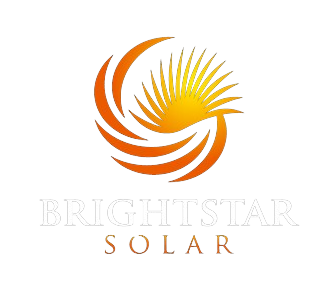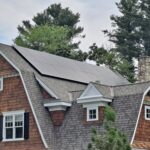There are many types of solar panels. They come in all shapes and sizes. How do you tell which one you’re dealing with? This is a great question — one I didn’t know the answer to when I first got acquainted with solar panels.
Let’s start off and discuss the three main types of photovoltaic (PV) panels:
- Monocrystalline Solar Panels – Monocrystalline cells are cut from a block of silicon that has been grown from a single crystal.These tend to be the most efficient, but also the most expensive solar panels. They have been considered the go-to panels for the last couple decades, and also boast being the oldest and most dependable.
- Polycrystalline Solar Panels – Polycrystalline cells are cut from multifaceted silicon crystal. They don’t come from a single piece of silicon crystal, but rather from many different crystals. These solar panels tend to be less efficient than monocrystalline solar panels of the same size. This means a 200 Watt Monocrystalline panel will usually be smaller than a 200 Watt Polycrystalline panel.
- Thin Film or Amorphous Solar Panels – These panels are not made up of any crystals. They are actually a thin layer of silicon deposited on a substrate or base material like metal or glass. Thin film solar panels tend to be the least efficient per square foot, but they are also the cheapest. The best application for amorphous panels is if you have a large amount of surface area and space doesn’t matter.
I talk a lot about efficiency above. I want to note that I am referring to efficiency per square foot. A 200 Watt Monocrystalline panel will generate as much electricity as a 200 Watt Polycrystalline panel or four 50 Watt Thin Film Panels. The main difference would be size.
So how can you tell which type of solar panel is which? It’s easy to tell the difference between monocrystalline and polycrystalline panels versus thin film panels. Monocrystalline and polycrystalline panels are rigid and much thicker than thin film. Thin film panels are flexible and they are, well, “thin.” Thin film also has a mostly uniform color.
Now let’s talk about the visual differences between monocrystalline and polycrystalline solar panels. Polycrystalline usually have a shattered glass look. This is because polycrystalline panels are made up from many different crystals put together. Monocrystalline panels tend to have more of a one-color look to them because they come from one crystal.
Brightstar Solar is a Massachusetts solar company specializing in residential and commercial installations. We can help you determine which type of solar panel is right for your project. Please contact us for a free solar evaluation of your home or business in Massachusetts.








Pingback: Tweets that mention Types of Solar Panels: Size, Shape, Color, & Efficiency — BRIGHTSTAR SOLAR -- Topsy.com
Hi there friends, how is everything, and what you desire to say about this post, in my view its actually remarkable
in favor of me.
Hey there! I just wanted to ask if you ever have any trouble with hackers?
My last blog (wordpress) was hacked and I ended up losing many months of hard work
due to no back up. Do you have any solutions to stop hackers?
I’m not that much of a internet reader to be honest
but your sites really nice, keep it up! I’ll go ahead and bookmark your
site to come back down the road. Cheers
This post will assist the internet viewers for creating new
website or even a blog from start to end.
I think the admin of this site is genuinely working hard in support of his web site, because here every data is
quality based information.
of course like your website but you need to take a look at the
spelling on several of your posts. Several of them are rife with spelling problems and I
in finding it very troublesome to inform the truth
on the other hand I will certainly come again again.
Hola! I’ve been following your site for a long time now and finally
got the bravery to go ahead and give you a shout out from Humble Tx!
Just wanted to say keep up the good job!
What’s up, just wanted to say, I enjoyed this blog post.
It was inspiring. Keep on posting!
Valuable information. Lucky me I found your website unintentionally,
and I am stunned why this accident didn’t took place earlier!
I bookmarked it.
It is truly a great and useful piece of info. I am glad that you simply shared this helpful information with us.
Please keep us up to date like this. Thanks
for sharing.
This article offers clear idea in favor of the new visitors of blogging,
that truly how to do running a blog.
Good blog you have got here.. It’s hard to find high quality writing like yours nowadays.
I truly appreciate people like you! Take care!!
Can you be more specific about the content of your article? After reading it, I still have some doubts. Hope you can help me.
I don’t think the title of your article matches the content lol. Just kidding, mainly because I had some doubts after reading the article.
When Anadrol is taken in today’s dosages of 50–100 mg/day, we now have found it to be
one of the worst steroids for cholesterol and blood pressure.
Distinctive increases in muscular power are also to be expected, with customers
commonly including 50 kilos to their compound lifts.
All of these compounds have vital fat-burning properties with none notable ranges of aromatization, thus enhancing muscle definition and vascularity.
Nonetheless, Deca Durabolin is usually stacked with other poisonous steroids, exacerbating blood lipids.
It is safe for most individuals to devour as much as 2 grams (g) per kilogram of
physique weight per day. Nevertheless, the Usa Anti-Doping Agency (USADA) emphasizes that this substance is unlawful and should not be in dietary supplements.
Moreover, despite claims it is “plant-based,” there aren’t
any reviews of scientists with the ability to isolate this substance from crops.
One can study lots a couple of product by studying different
individuals’s experiences. Customers usually write reviews of merchandise after having an excellent or dangerous
experience with them, so these reviews can provide
individuals accurate information about how nicely
a product works. Firms that make good dietary supplements normally supply refunds
or guarantees to offer their customers peace of mind after they purchase their products.
This focused motion is what makes SARMs so interesting for both medicine and
efficiency enhancement. SARMs, in any other case known as Selective Androgen Receptor Modulators, are a well-liked choice for
these looking to enhance their fitness and muscle-building objectives.
As you can see, all of these dietary supplements are legal
options to well-liked bodybuilding steroids. Furthermore, TestoPrime can considerably enhance muscle
power and endurance ranges during a hardcore exercise
on the health club.
The Meals and Drug Administration (FDA) does not approve prohormones for human use.
This means they can’t be offered as dietary dietary supplements or utilized in foods safely.
Promoting objects not approved by the FDA breaks marketing and labeling laws.
At the end of the day, these supplements (and even steroids) are merely aids
to your precise training in the fitness center – nothing can complement the hard work you set in day in and time
out. Relying in your overall physiology you could experience
skin issues, similar to acne, rapid hair progress, hair loss and edema.
Many Winstrol users could expertise erectile dysfunction, testicular atrophy, insomnia, immune dysfunction and
much more. As with any drug that will increase your our bodies ability to carry purple blood cells, you will have an elevated oxygen carrying capacity.
A legal various to Sustanon that naturally increases testosterone without damaging one’s health.
Before I tell you all about the best legal steroid options you should understand that these
products usually are not right for everybody.
Fortunately, there are safe steroid alternate options
you have to use to help you to reach your goals. Testosterone is of course produced by the
physique and is responsible for muscle achieve, strength and a variety of other issues.
We only advocate dietary supplements that contain components in quantities which are effective for men. Even with
out the use of steroids, you can probably jack up a major amount of muscle mass.
If you want to compete, you can go ahead
even without the usage of Real steroids for sale Online.
Thus, we can suffice by saying steroids aren’t any
good, and the unwanted facet effects are sufficient to sabotage their in style
picture. As An Alternative, if you do need to try
a complement, give a try to the aforementioned legal complement blends and see how they work out for you.
Also, the pure formulation ensures you don’t encounter any major harmful results.
Nonetheless, it’s greatest to verify the components for allergy symptoms before use.
It is at all times good to seek the assistance of with
a healthcare professional before use. This makes them simple to ingest, as well as being safer
to administer than the typical anabolic steroid injection. We meticulously researched and analyzed
numerous authorized steroids obtainable at leading manufacturers, including Walmart, to pick
the most effective ones. Critical unwanted
effects are rare when utilizing authorized steroids designed for chopping.
Nonetheless, it’s important to observe dosage guidelines and seek
the guidance of a healthcare professional should
you experience any adverse effects.
It is probably one of the finest tools in case you are seeking to reduce fat
without dropping muscle mass. “Main Reasons to Choose Winsol Legal anabolic dietary supplements like Winsol typically don’t get the recognition they deserve because of their wide-ranging advantages. Observers would possibly dismiss it, arguing that it’s neither a muscle enhancer nor a fat reducer. It will allow you to bulk up rapidly and will make high quality muscle development with out including fat. The major distinction between D-Bal and D-Bal max is the finish to the muscle growth. One is a harder and ribbed finish, while the other one is a extra rounded finish.